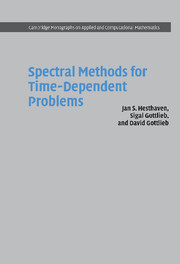Book contents
- Frontmatter
- Contents
- Introduction
- 1 From local to global approximation
- 2 Trigonometric polynomial approximation
- 3 Fourier spectral methods
- 4 Orthogonal polynomials
- 5 Polynomial expansions
- 6 Polynomial approximation theory for smooth functions
- 7 Polynomial spectral methods
- 8 Stability of polynomial spectral methods
- 9 Spectral methods for nonsmooth problems
- 10 Discrete stability and time integration
- 11 Computational aspects
- 12 Spectral methods on general grids
- Appendix A Elements of convergence theory
- Appendix B A zoo of polynomials
- Bibliography
- Index
11 - Computational aspects
Published online by Cambridge University Press: 04 December 2009
- Frontmatter
- Contents
- Introduction
- 1 From local to global approximation
- 2 Trigonometric polynomial approximation
- 3 Fourier spectral methods
- 4 Orthogonal polynomials
- 5 Polynomial expansions
- 6 Polynomial approximation theory for smooth functions
- 7 Polynomial spectral methods
- 8 Stability of polynomial spectral methods
- 9 Spectral methods for nonsmooth problems
- 10 Discrete stability and time integration
- 11 Computational aspects
- 12 Spectral methods on general grids
- Appendix A Elements of convergence theory
- Appendix B A zoo of polynomials
- Bibliography
- Index
Summary
Up to this point, we have mainly discussed the theoretical aspects of spectral methods. We now turn to some of the computational issues surrounding these methods, and discuss the tools needed for efficient implementation of trigonometric and polynomial spectral methods. We shall also discuss the practical problems of round-off errors and aliasing errors. Finally, we address problems requiring the use of mappings.
Fast computation of interpolation and differentiation
The appearance of the fast Fourier transform (FFT) in 1965 revolutionized entire fields within science and engineering. By establishing a fast way of evaluating discrete Fourier series and their inverses, this single algorithm allowed the use of methods that were previously impractical due to excessive computational cost.
Fourier spectral methods emerged as efficient methods of computation due to the introduction of the FFT, and a significant part of the fundamental theory of Fourier spectral methodswas developed in the decade immediately following the introduction of the FFT. In the following we briefly discuss the key idea behind the FFT. However, the idea behind the FFT is valid only when dealing with trigonometric polynomials, and by extension, Chebyshev polynomials; it is not, in general, applicable to polynomial spectral methods. Therefore, we shall continue by discussing alternative fast methods for the computation of interpolation and differentiation for polynomial based methods. We conclude with a brief section on how to compute the general Gaussian quadrature points and weights needed to compute the discrete polynomial expansion coefficients.
- Type
- Chapter
- Information
- Spectral Methods for Time-Dependent Problems , pp. 204 - 234Publisher: Cambridge University PressPrint publication year: 2007

